Your lead capture form will make or break your landing page. Yet, I see countless forms that just don’t cut it.
And sadly, most advice out there on lead capture forms is just recycled fluff, like “use persuasive CTAs” or “don’t ask for too much personal info.”
Yeah, we’ve heard it all before! 😫
In this post, I’m skipping the fluff and diving straight to actionable guidance on how to build a high-converting lead capture form that reels in not just more leads, but better leads too.
All based on my experience of analyzing the highest converting lead capture forms that were built with GetLeadForms.
So, buckle up, and let’s get started!
Avoid these blunders: Here’s what makes a bad lead capture form
Alright, let’s get down to business with some lead capture form best practices.
First, we’ll establish a baseline of what I consider a lousy lead capture form.
Have a peek at this:
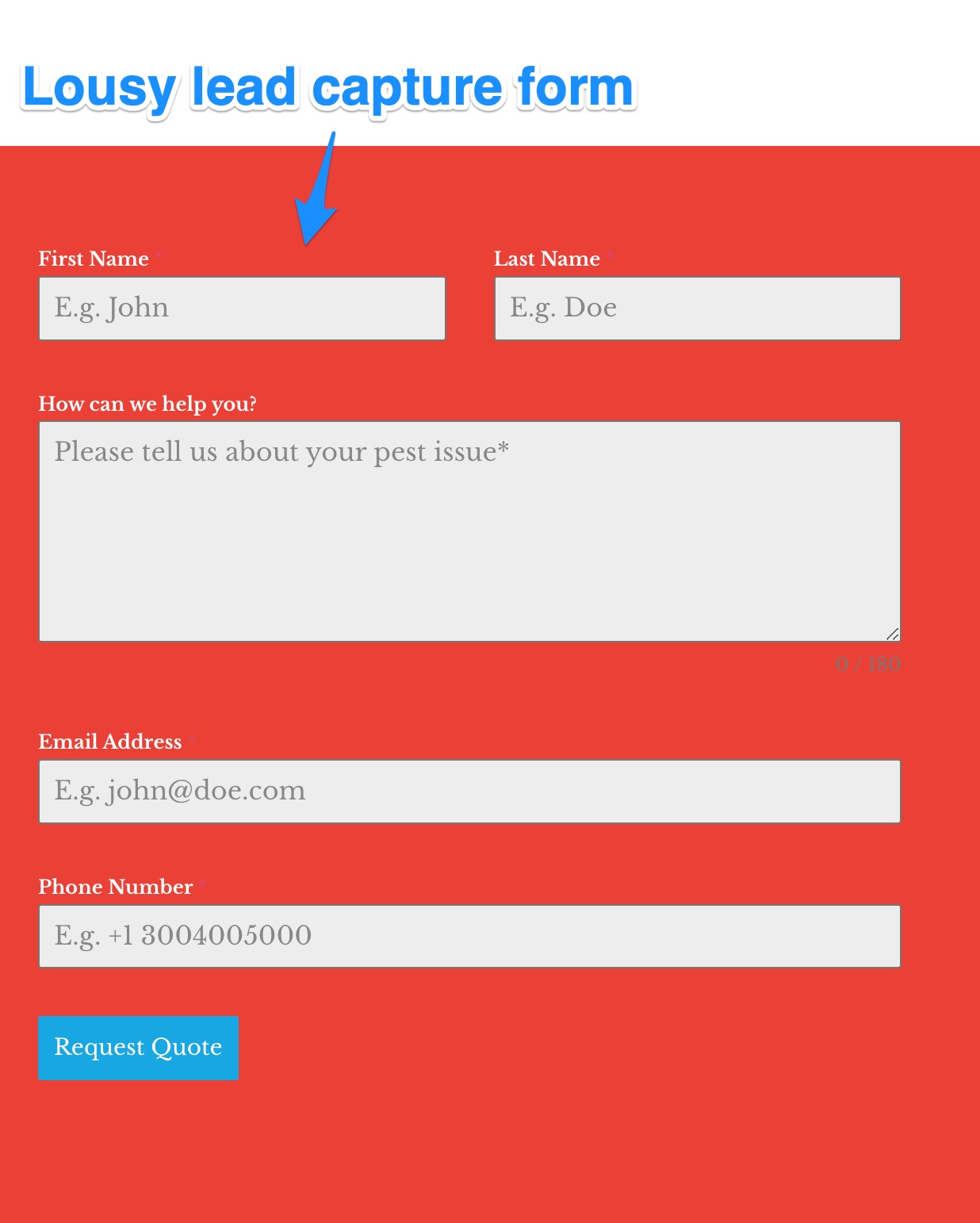
You might be thinking, “Hey, this isn’t too shabby.”
I mean, it’s pretty straightforward, right?
It kinda looks like a typical form that you see on most sites, especially local services.
And that’s exactly where the problem lies!
This form? Well, it’s missing a catchy call to action to hit that ‘submit’ button.
Kinda like a house with no curb appeal, if you catch my drift.
But here’s the thing.
Since one small issue with your form could dramatically affect your conversion rates, your lead capture form should never be an afterthought.
So, now you might be thinking… what is a bad form?
Usually, bad forms are:
- Too short — fewer fields can actually be counter-productive.
- Too long
- Treated as an afterthought
- Missing qualifying questions to filter out bad leads
Now that we’ve seen the ugly side, let’s explore the five key building blocks of a high-converting lead capture form.
Want to see some cool examples of high-converting lead capture forms, check out this post.
My blueprint for creating the best lead capture forms that convert
Let’s dive into my secret sauce for a high-converting lead capture form.
Just so you know, I didn’t pluck this blueprint out of thin air.
I got my Sherlock Holmes on and analyzed the best capture forms made with GetLeadForms. Guess what? I found five common threads.

I asked myself, “How can I share this awesome info with GetLeadForms users and non-users alike, so they can create awesome lead capture forms too?”
And eureka!
I realized I could bundle it up into a nifty framework, usable for any form. Nope, you don’t have to be a GetLeadForms user to get this framework working for your lead capture forms. But hey, using GetLeadForms could definitely make your life a bit easier. You can grab a free trial here.
So, here are the five building blocks in my blueprints.
- Building Block #1: The Offer
- Building Block #2: The Micro Commitment
- Building Block #3: Social Proof
- Building Block #4: Add qualifying questions to your form
- Building Block #5: Show the human on the other side of the form
Now, let’s break down each in the sections below.
Building Block #1: The Offer
The offer is literally one of the most important parts of any form.
But so many marketers and businesses totally drop the ball here.
The offer can single handly be the difference between a form that converts like crazy and a form that doesn’t convert.
So what do I mean by the offer?
When I say “offer”, what I’m really talking about is what you’re giving to your audience in exchange for their information. It’s the value proposition, the reason why someone would want to fill out your form in the first place.

For example, let’s say you run a fitness blog.
Your offer could be a free e-book titled: “10 Secrets to a Killer Six-Pack.”
In this case, it’s exclusive content that provides value to your audience – they get professional fitness tips, and all they have to do is give you their email address.
Or perhaps you’re in the personal injury space. Your offer could be to get a free case evaluation.
If you’re in the local service space, your offer might be a free quote or consultation.
A great offer is attractive, relevant to your audience, and provides real value. It’s the thing that gets people to engage with your form.
Here are a few ideas on how to sneak an offer into your lead capture form without being too obvious.
Check out this first lead capture form example. The offer is sitting at the top of the form. Since it’s a multi-step form, we made sure the offer sticks around for the whole journey. That way, we never have to worry about the prospect forgetting what’s up for grabs.
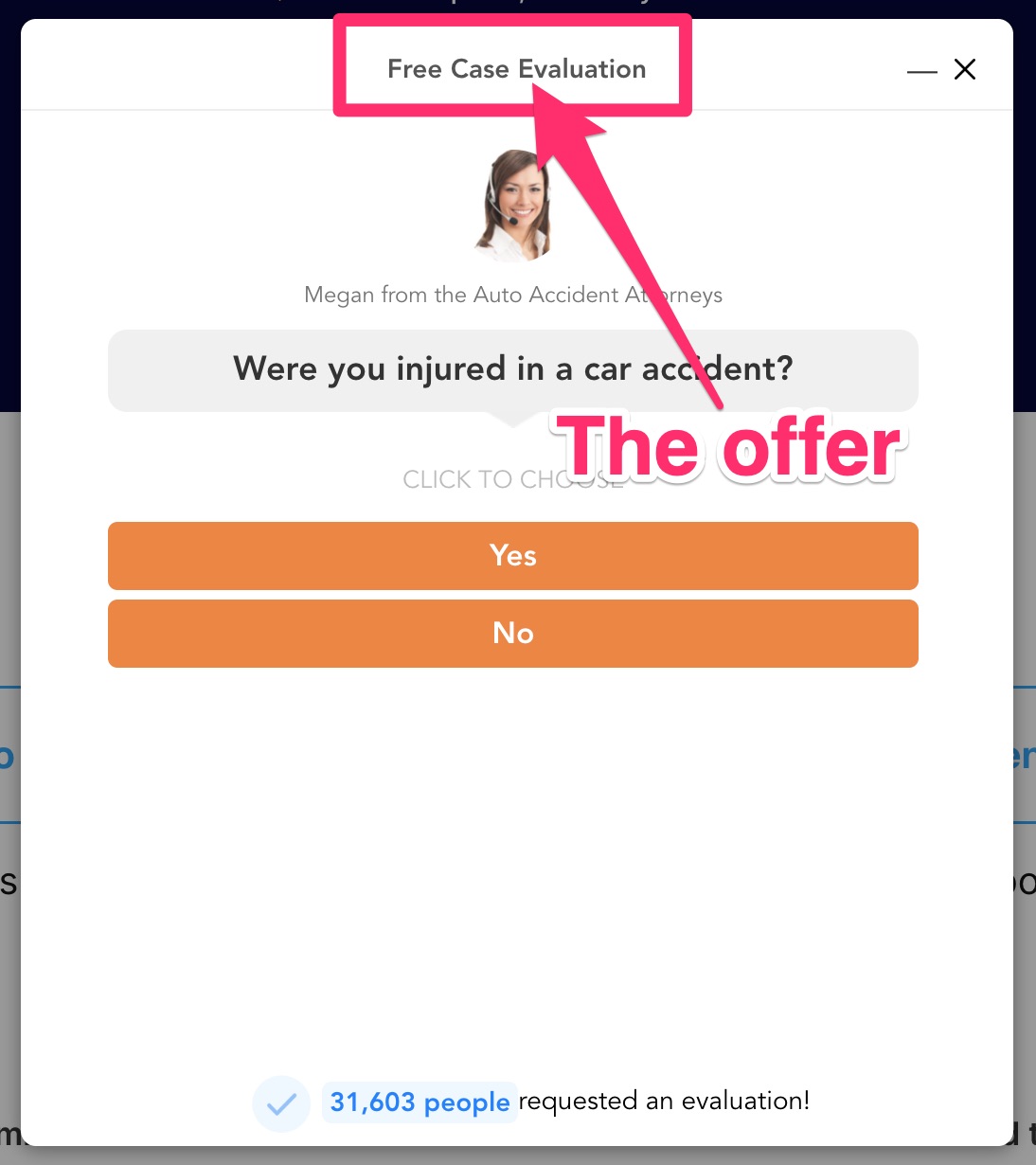
Now, look at this second example. We slid the offer right into the copy of the first step. The prospect has to read it, so they can’t miss it.
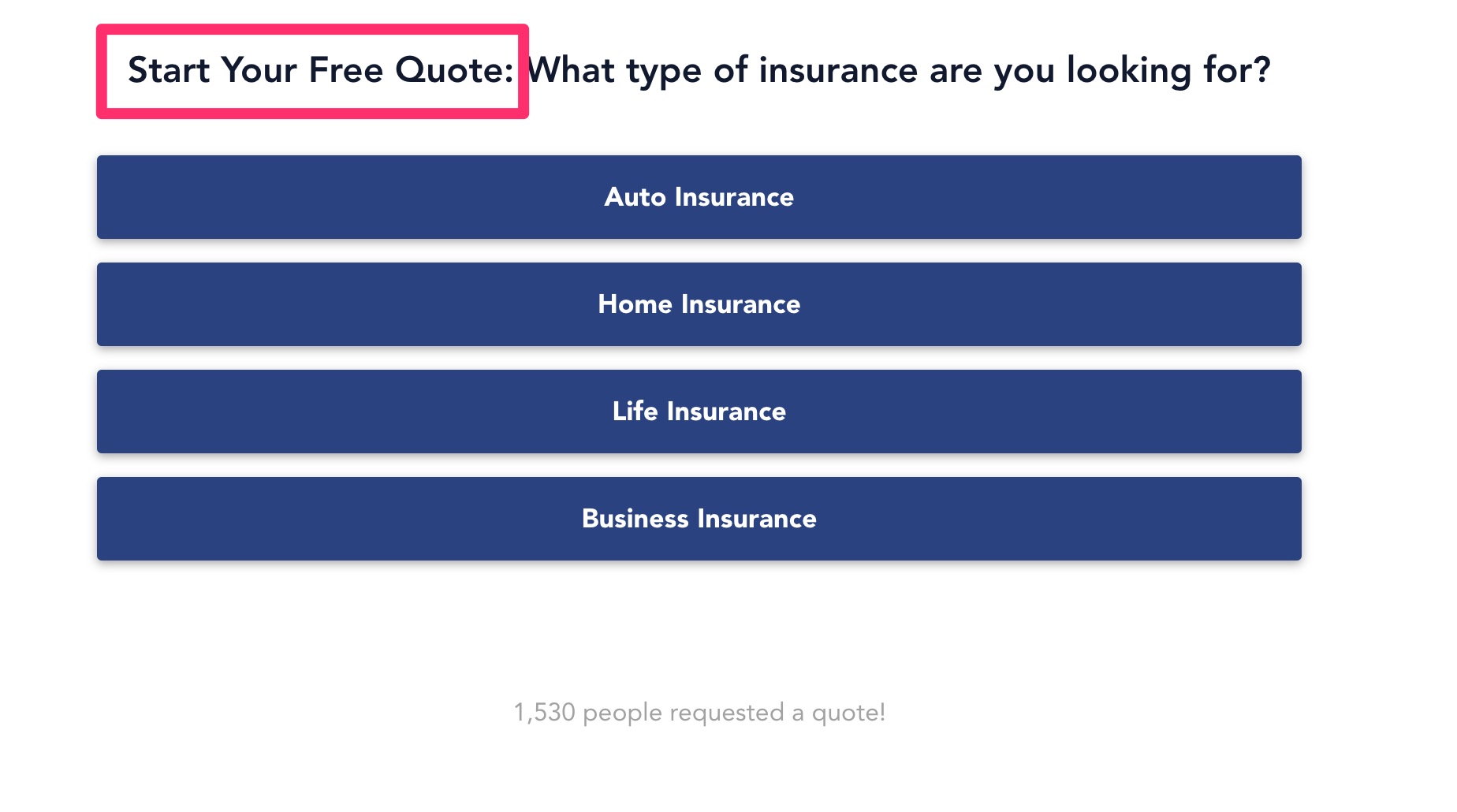
For this third example, we’re reinforcing the offer at the final step in three different spots, including the call-to-action, just when we’re about to ask the prospect for their treasured contact details.
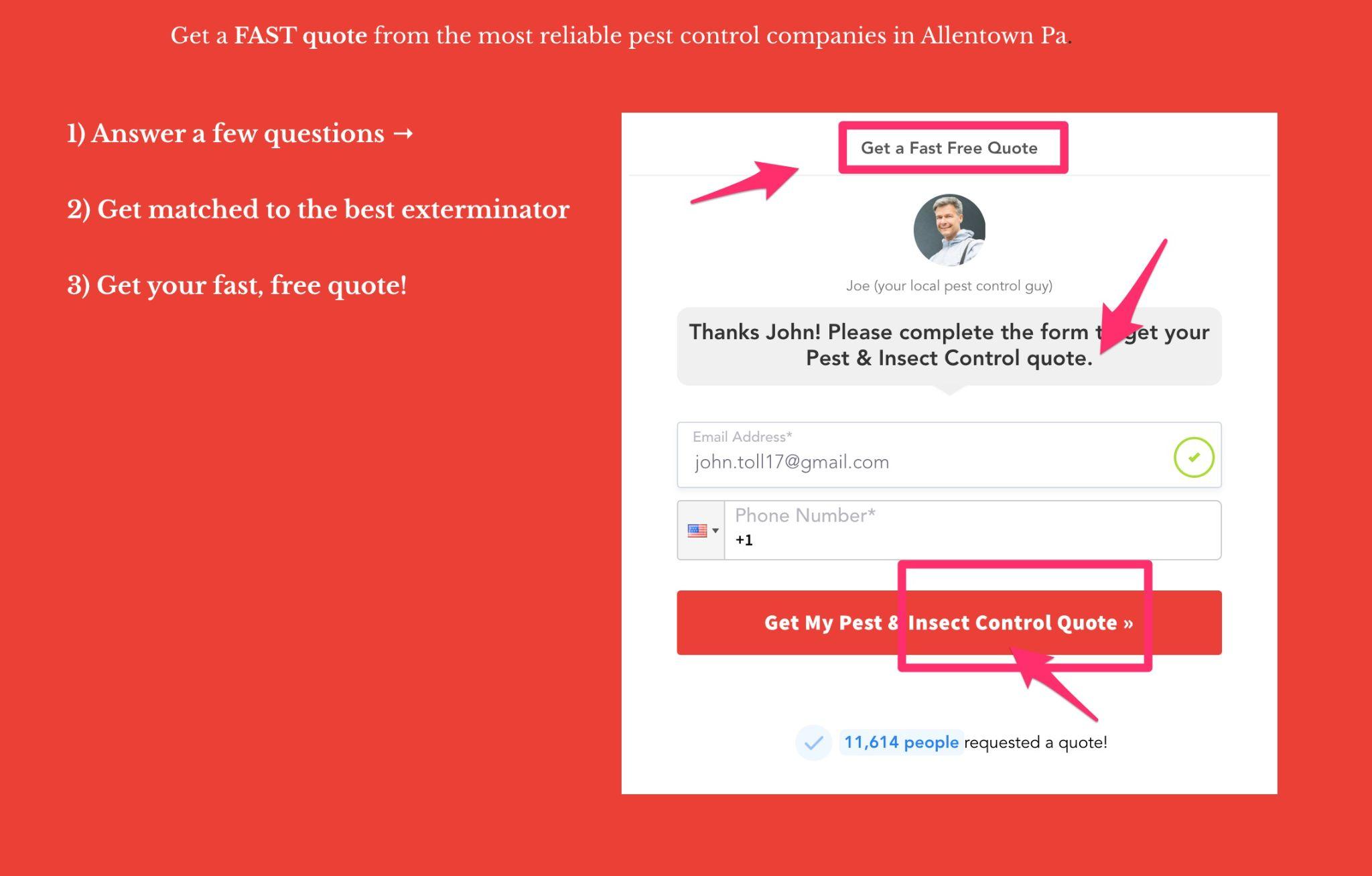
Check out this form example and grab the template here!
One tip I always give – make sure to bring your offer back into the spotlight on the last step of your form, especially when you’re asking for personal info like an email address or phone number.
Why?
Well, from what I’ve seen in the data, fields asking for personal details are where we see the most drop-off. So, make your offer and make it irresistible.
Building Block #2: The Micro Commitment
If you haven’t heard about “micro-commitments,” let me fill you in on what a micro-commitment is and why it’s the key to unlocking more conversions for your lead capture forms.
A micro-commitment is a persuasive technique rooted in Robert Cialdini’s idea of commitment and consistency.
Simply put, he says that we humans like to stick to our guns, even when the original reason or spark for doing something isn’t there anymore.
Imagine micro-commitments as breadcrumbs leading a prospect down the path – something like clicking a button, filling in a single box on a form, or even just agreeing with something you’ve said.
Here’s the magic of it: every time someone makes a micro-commitment, they’re getting more and more involved in the process.
It’s like we’re programmed to stay on track.
Plus, taking lots of little steps can feel way less daunting than one big giant leap. It’s all about staying consistent – once folks start moving, they’re more likely to keep going so that their actions match up.
It just so happens that you can use micro-commitments to supercharge your lead capture forms and drive up those conversion rates.
But how, you ask?
It’s all about starting off with easy questions that don’t feel like a big ask, then gradually upping the ante.
Let’s face it, in today’s world, data is like gold. So asking someone for their phone number straight off the bat is like asking for their firstborn. But if you start with something less personal, like their budget, it feels way less intrusive.
Check out this example of a micro-commitment in action. See how we’re gently nudging the prospect by asking them a simple yes/no question — have you filed for bankruptcy?
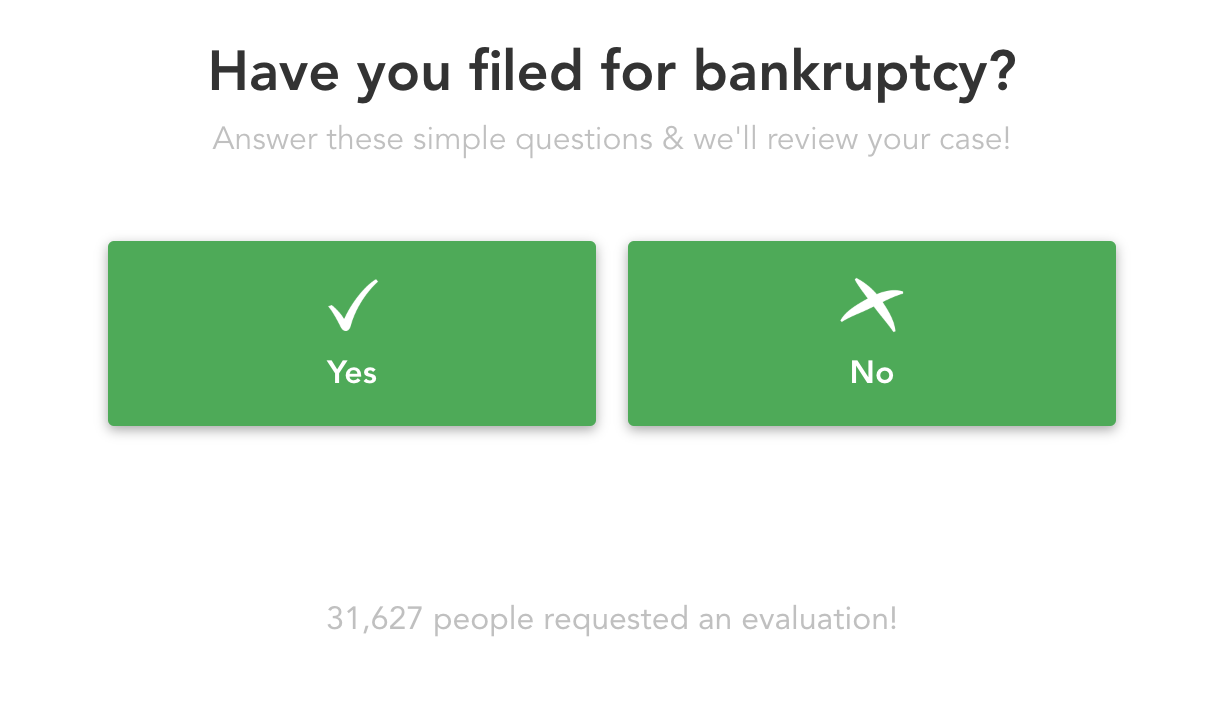
In this other example, we’re simply asking the prospect to enter their zip code, which could even be auto-filled to make life even easier.
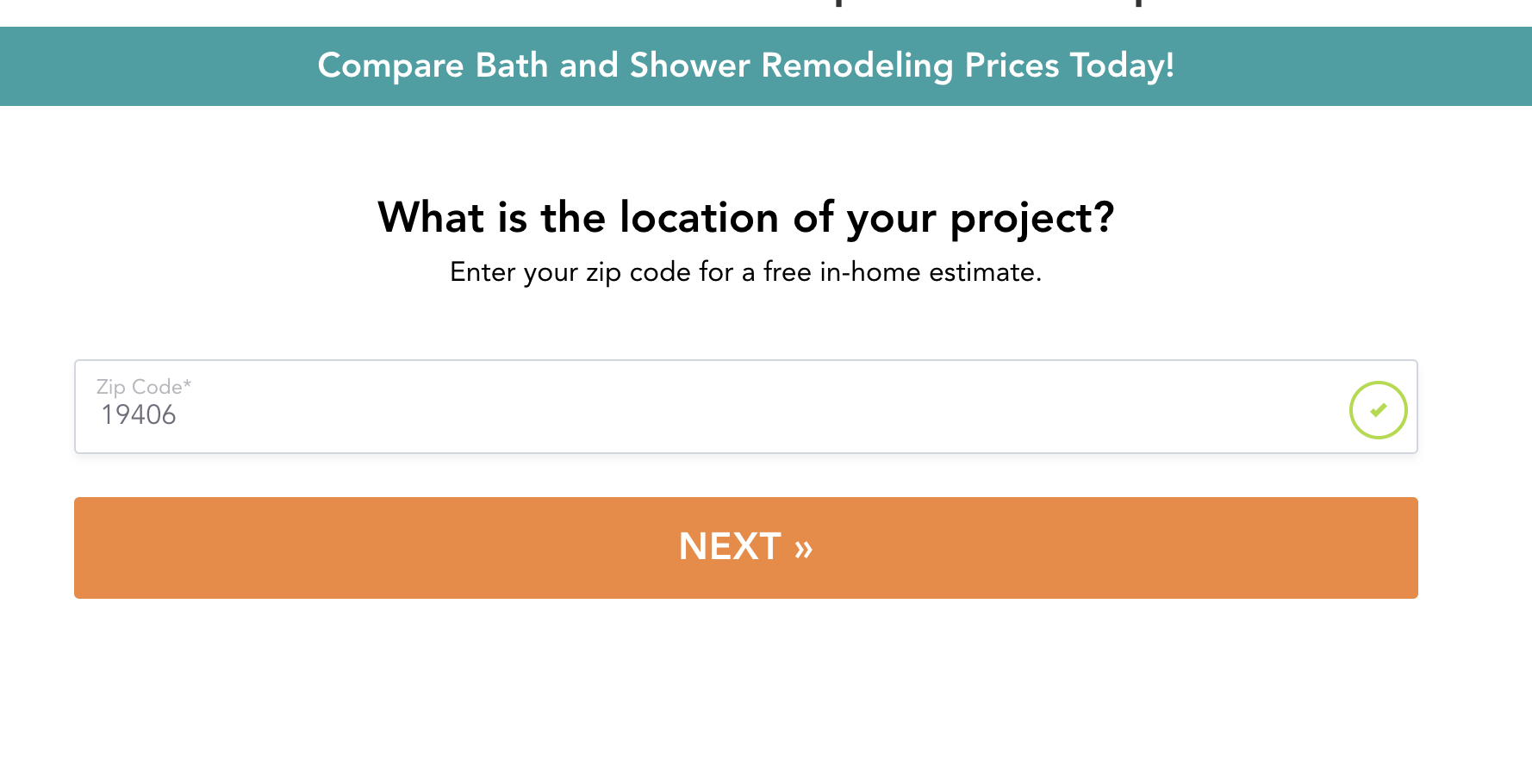
In this case, the zip code even auto-fills. Meaning all the prospect has to do is literally click ‘Next’ — it couldn’t be any easier!
See this form in action and swipe it for your own campaigns here.
And guess what? I’m not the only one who’s caught on to the power of micro-commitments. HomeAdvisor has been onto this trick for ages, and they’re still sticking with the zip code question in most of their forms.
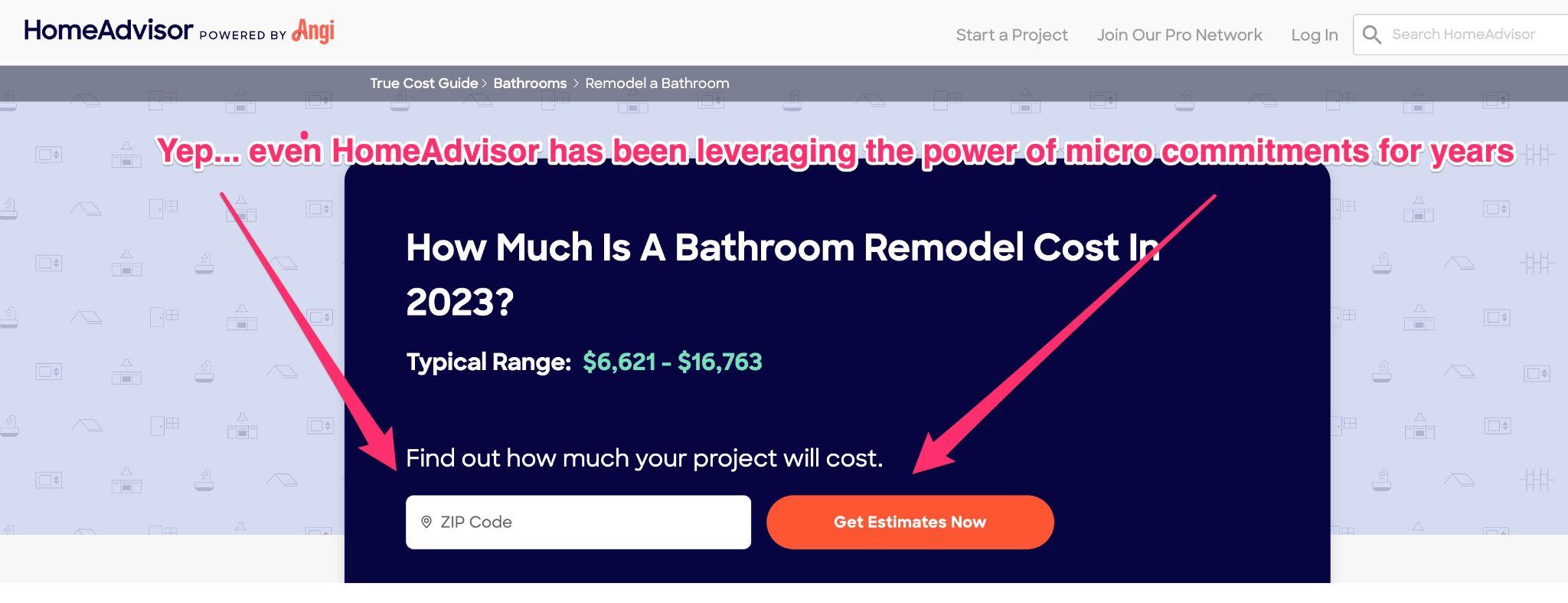
The takeaway? Start small and build up the intensity. Don’t get too greedy and try to grab all the juicy contact details right at the beginning of your form. That’s a ticket for low conversions.
Building Block #3: Social Proof
If you ask a bunch of marketers about the must-haves for any landing page, I bet you that social proof will be right up there on everyone’s list.
At this point, I don’t think I need to bore you with a bunch of stats showing why social proof is so powerful.
And frankly, I don’t want to burn my time digging up those studies just to make a point you probably already agree with.
So, let’s skip the formalities and jump right in.
One clever little trick that most people often overlook is adding social proof directly into your forms. Like this:
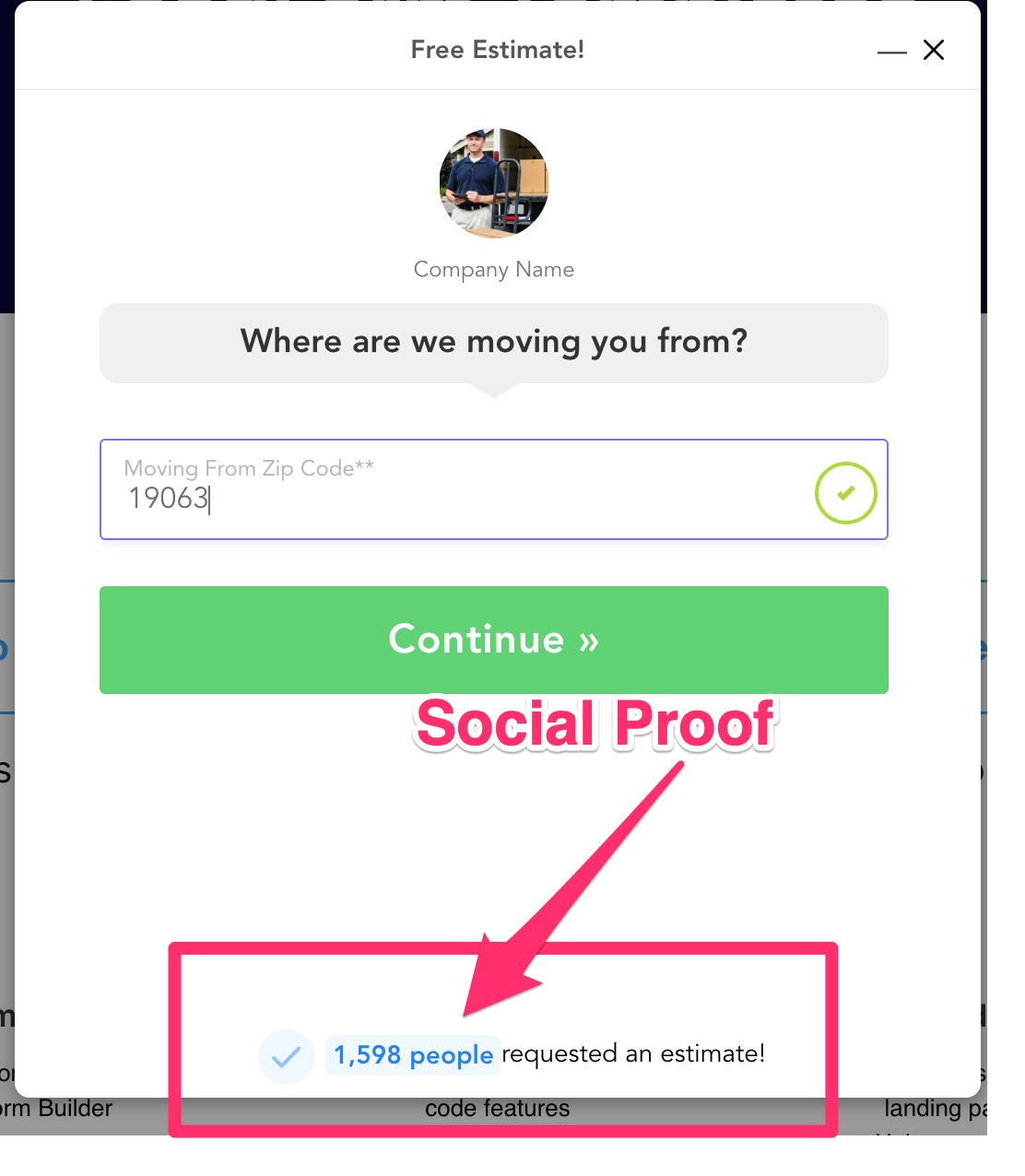
And to really up the ante, make it real-time.
I remember the lightbulb moment when this idea hit me.
I was hanging out on a website, watching real-time social proof pop-ups zipping around in the bottom right corner of the page.
Upon seeing that, I told my developer to weave it into all our forms. The moment we did, our conversion rates shot up. Pretty neat, huh?
Now, if you’re using GetLeadForms, you can switch social proof on or off with a click of a button in your dashboard.
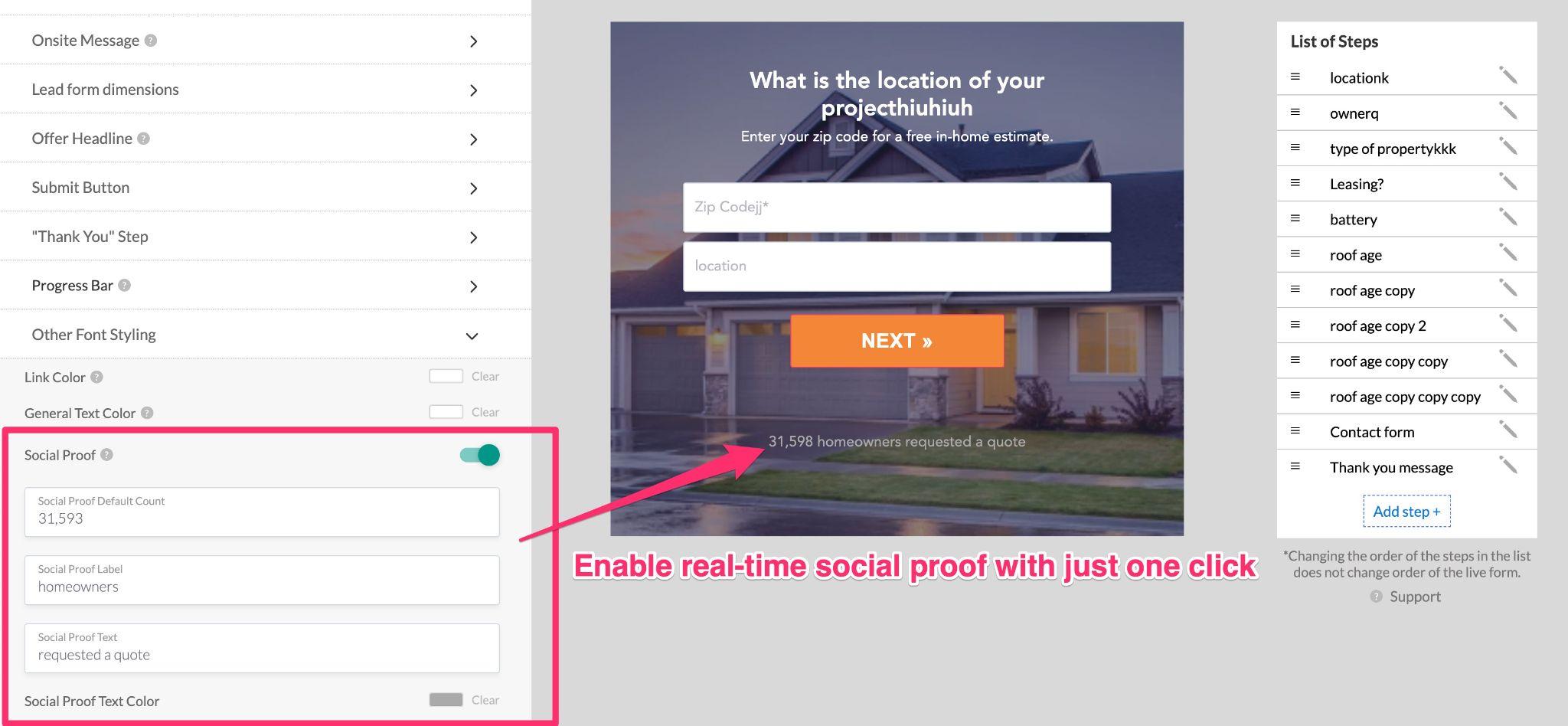
And no sweat about tracking this manually. The system’s got your back and will do it for you.
Building Block #4: Add Qualifying Questions to Your Form
Let’s be real here – when it comes to leads, it’s all about quality over quantity.
In fact, bombarding your team or clients with a bunch of low-quality leads isn’t gonna cut it.
An amazing lead capture form isn’t just about getting a ton of leads. It’s about getting leads that are actually worth the effort.
Here’s the catch, though.
Lots of marketers freak out at the idea of adding more fields to their forms. Which is understandable.
But let me tell you, from my experience, it’s a must-do.
Now for the silver lining.
You don’t have to overdo it. Once your form starts looking like a final exam with dozens of questions, your conversion rates are likely to take a nosedive.
My advice? Stick to 1-3 crucial qualifying questions.
For instance, a roofing company might want to know a few extra details about the homeowner’s roof before they reach out. Notice how in this example, qualifying questions are asked right in the lead capture form.
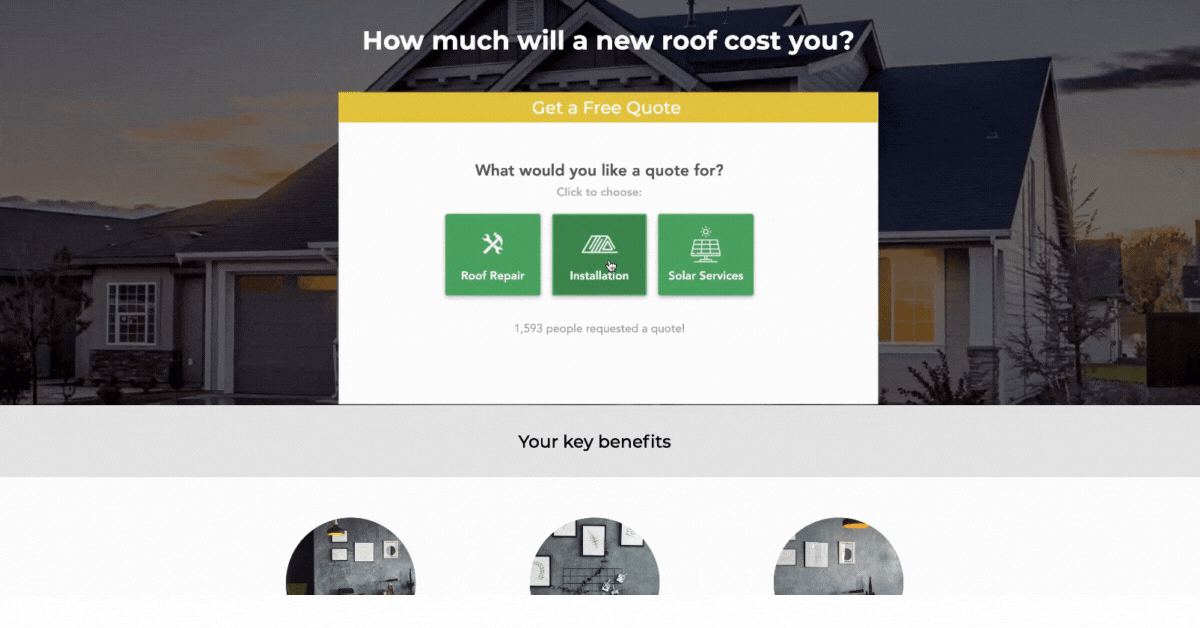
The bottom line — qualifying questions are a must-have for a solid lead capture form, even if they bring down your conversion rates a smidge. Just remember, don’t go overboard with the questions.
Building Block #5: Show the Human on the Other Side of Your Form
Personalization is all the rage these days.
We’re personalizing our emails, our ads, our websites, you name it.
But why are we leaving our forms out in the cold?
Now, I’m not talking about the kind of personalization that’s so intense it gets creepy. You know, like when a B2B company uses your IP address to find out your company name, which it then weaves into their website somewhere (way too invasive, right?).
I’m just talking about showing the person behind the form. Something like this:
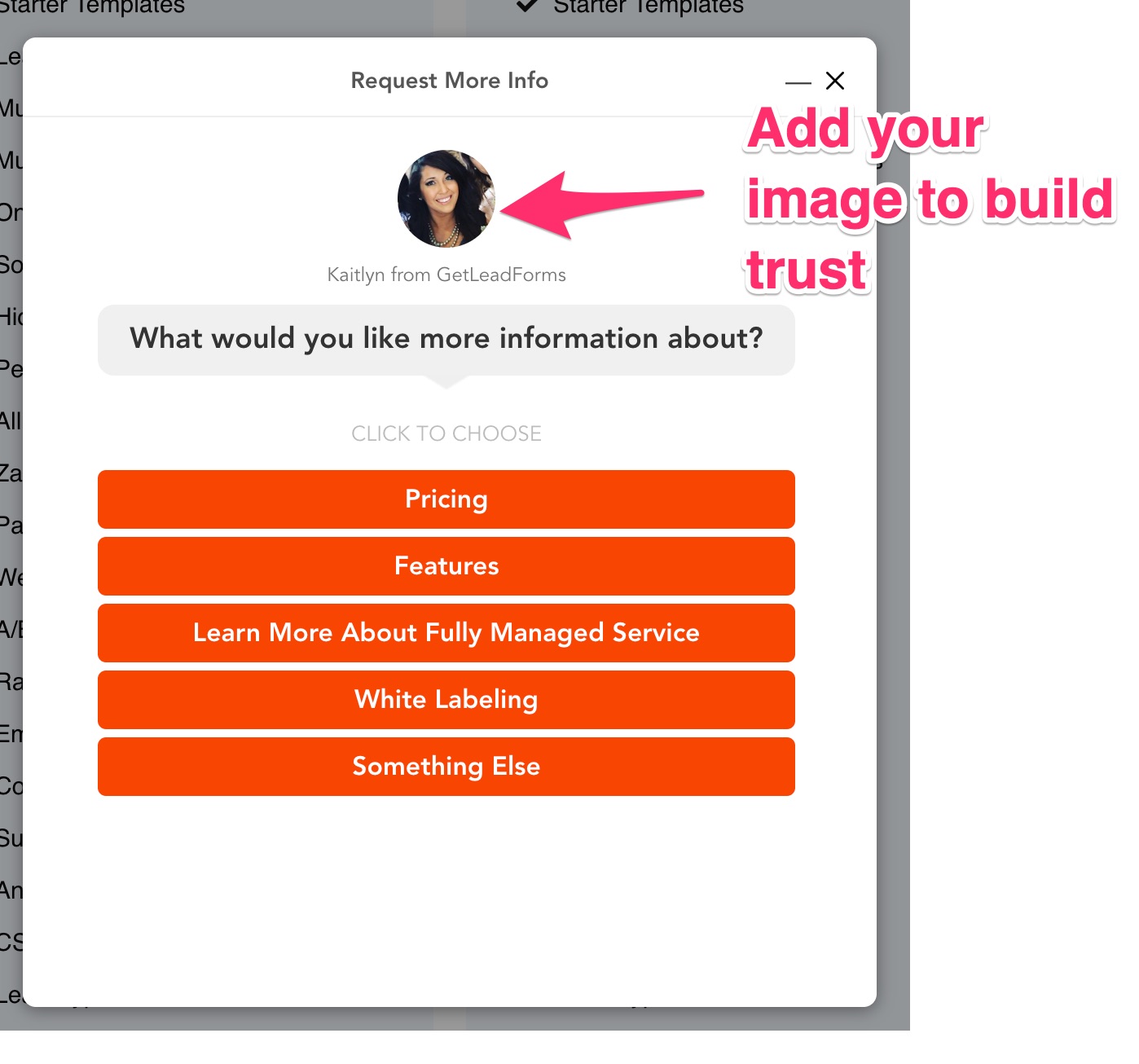
You can see this form in action right on our pricing page.
Seriously, it’s as simple as that.
Just snap a quick selfie with your phone and slap it onto your form.
If you’re like me and you’re convinced you’ll break the camera, get someone else to take the pic.
When I gave this a go, I saw my conversion rates jump up by 35%. The reason why this works is because it helps build trust.
And a lead capture form that builds trust is a lead capture form that converts.
Final thoughts and more lead capture form examples
And that’s a wrap!
Remember, your lead capture form is the linchpin of your landing page, and it’s time it gets the attention it deserves.
Forget the same old advice you’ve heard a million times – we’ve gone way deeper in this post, serving up the real deal blueprint or building a top-notch form that doesn’t just attract more leads, but better leads too.
In case you skipped to the end like I usually do, here are the building blocks that I discussed:
- Make a compelling offer
- Use micro-commitments
- Leverage social proof
- Include qualifying questions
- Show the human behind the form
These building blocks are just the start. In a future post, I’ll dive into the next layer — what I call the nuts, and bolts, which includes things like compliance, making your forms easy to find, and so on.
Looking for lead capture form templates?
Check out some high-converting lead capture form templates here.
